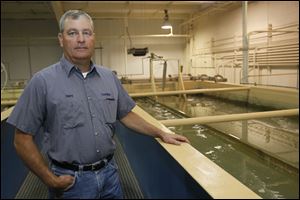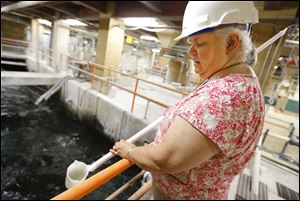
Carroll Township’s scare with toxin a ‘wake-up call’
Water plant shut over lethal microcystin from algae
9/15/2013
Henry Biggert is confident he ‘made the right call’ to shut down the Carroll Township Water Plant when he detected microcystin, a potentially lethal toxin.
THE BLADE/JETTA FRASER
Buy This Image

Henry Biggert is confident he ‘made the right call’ to shut down the Carroll Township Water Plant when he detected microcystin, a potentially lethal toxin.
OAK HARBOR, Ohio — They got lucky.
The 2,000 residents of Ottawa County’s Carroll Township who were told to avoid their tap water last weekend can thank one person — not any one of America’s thousands of state and federal health laws — for sparing them from sickness, possibly even death.
Henry Biggert, the township’s water plant superintendent since it went online in 1998, knew he had to act fast when he saw microcystin, the potentially lethal toxin in Lake Erie’s harmful, blue-green algae known as microcystis, spike to a level beyond plant capability Sept. 5.
He took the unprecedented action of shutting down the plant and flushing out the system, the first time a publicly owned water-treatment facility in Ohio did that because of an impending threat by an algae-related toxin.
Click here to view related gallery.
The decision he made a few years ago to test for the toxin once a week during algae blooms was voluntary.
Unknown to many people, the U.S. Environmental Protection Agency does not require publicly operated water-treatment plants to test for microcystin or any of the other so-called cyanotoxins — that is, toxins associated with harmful blue-green algae.
Microcystin is the same toxin that killed 75 people in Brazil in 1996. It has been the dominant one in western Lake Erie for nearly each of the past 18 summers, including this one.

Chief chemist Brenda Snyder takes a sample at Toledo's water treatment plant. The plant is envied because water travels long way. Particles get more time to bond, making the water easier to treat.
Rules for testing
The Ohio EPA, which falls back on U.S. EPA rules as the basis for most of Ohio’s environmental laws, leaves the decision to perform one of northwest Ohio’s most vital water-quality tests up to individual plants on a voluntary basis.
Toledo, Oregon, Ottawa County, Findlay, Clyde, and — luckily for those 2,000 residents last week — Carroll Township are among area water plants that have taken it upon themselves to test for microcystin voluntarily.
But most test only on a weekly basis, unless a potential crisis such as last weekend’s emerges.
That means that during normal conditions, the level of toxin in any given water plant may be unknown for six of seven days each week.
“It comes down to economics,” said Brenda Snyder, chief chemist at the Collins Park Water Treatment Plant in Toledo. “If you need to test daily for it, you need six times the labor and six times the supplies. I would love to test for it every day, but there’s a limit.”

Dave Welch, Toledo director of utilities, sees Carroll Township's emergency as a 'wake-up call.' Toledo has no other system into which it could hook into nor enough bottled water for residents.
‘The right call’
Most people don’t know the name of their local water-treatment plant superintendent.
That could be changing in Carroll Township.
Mr. Biggert, who has 25 years of experience in water treatment, said last week he remains comfortable about his decision to temporarily disable Carroll Township’s water plant.
“Looking back, it was the right call,” Mr. Biggert said. “I couldn’t close my eyes and hope it would go away.”
Weekly test results showed the plant had become overwhelmed by microcystin: The toxin was detected at 3.56 parts per billion, more than 3½ times the threshold of 1.0 part per billion established by the World Health Organization.
And Ms. Snyder is one of many scientists who wonder aloud if that World Health Organization standard is conservative enough. The U.S. EPA has been contemplating that too.
“At this point in time, it’s the best standard we have,” said Mike Baker, chief of the Ohio EPA’s division of drinking water and ground waters.
Mr. Baker said he has “no intention” of going to the Ohio General Assembly to seek passage of a law that would make testing mandatory.
“I don’t need the authority,” he said. “We have very close, cooperative working relationships with the water utilities. They’ve been extremely responsive to sampling requests.”
But some cash-strapped communities, such as Toledo, have cut back on vital services such as police protection.
Budget priorities?
Groups that track budgeting have noted environmental protection is often viewed by politicians as a soft target for cutbacks. The U.S. EPA’s Clean Water State Revolving Fund, for example, the largest fund in that agency’s budget and one used for overdue sewage work, has been subject to billions of dollars in cuts over the years as Congress tried to reduce the federal deficit.
Mr. Baker said the Ohio EPA likely will continue to yield to the federal EPA’s guidance on toxic algae. He said most public officials realize safe drinking water is too important to be politicized.
Mr. Biggert said he expects to receive support from his township board for more frequent testing if he needs it. He said it will take awhile to assess what happened.
“We take our jobs of producing the safest water we possibly can very seriously,” Mr. Biggert said.

Microcystin stays in Lake Erie long after the algal bloom fades in about mid-October, but no one is sure how long, noted David Leffler, commissioner-plant operations at Toledo's water treatment plant.
Scary situation
For nearly 48 hours, Carroll Township officials sweated it out: Did everyone know they weren’t supposed to drink or cook with their tap water until further notice?
The media advisory issued after Mr. Biggert’s decision at 5:30 p.m. Sept. 5 urged people not to boil their water.
Boiling doesn’t kill the toxin. It concentrates it.
At least 16 pallets of bottled water were distributed Sept. 6.
The advisory was lifted Sept. 7, shortly before 2:30 p.m. Although there were a lot of questions from confused residents, nobody was known to have become ill from the toxin.
The Ohio EPA, which was reluctant to discuss the issue for most of last week, said Friday the event showed that “cooperative voluntary measures work.”
It cited the case as an example of how a potential crisis can be averted through teamwork involving its agency and others.
But one of the township’s higher-profile residents, Kim Kaufman, executive director of the Black Swamp Bird Observatory, said in a Facebook post that it was, indeed, a scary event.
“Only a handful of Carroll Township residents were notified about this,” she wrote. “We [Ms. Kaufman and her husband, Kenn, one of North America’s top bird experts] found out when a friend read it on Facebook and warned us. Many people didn’t find out for more than 24 hours.”
The dangers
Linda Merchant-Masonbrink, Ohio EPA harmful algae bloom coordinator, told a group of Great Lakes writers on Aug. 26, during an annual workshop at Ohio State University’s Stone Laboratory on Lake Erie’s Gibraltar Island, that the toxin needs to be taken seriously.
The latest research places the potential toxicity of microcystin between DDT and dioxin, she said.
Ms. Merchant-Masonbrink said it can cause myriad health problems, from nausea to permanent neurological damage, within minutes of ingestion.
At high levels, it can be lethal.
No humans are known to have have died from it in North America. But some dogs and other animals are believed to have succumbed from it.
The 1996 deaths in Brazil, investigated by the U.S. Centers for Disease Control and Prevention, were the result of a breakdown in a kidney dialysis center’s on-site water-treatment system.
Lingering threat?
Research also shows the toxin remains embedded in Lake Erie long after the annual bloom fades, usually by mid-October.
Scientists don’t know if the toxin lingers for weeks or months, Ms. Merchant-Masonbrink said.
That’s a key question for public health and safety, because the toxin — unlike the stinky, pea-green algae — is odorless and colorless, she said.
David Leffler, Toledo’s commissioner-plant operations, agreed there is “no direct correlation between the toxin and the algae.”
Stacy Kika, spokesman for the U.S. EPA’s headquarters in Washington, said the length of time the toxin lingers is unknown.
“Toxins can accumulate in sediments and be released later,” she said.
Ms. Merchant-Masonbrink handed out business cards and encouraged reporters to contact her after her Stone Lab presentation.
The Ohio EPA declined to let The Blade do a follow-up interview with her for this story.
‘Emerging science’
But in a prepared statement, the agency said the study of algal toxins is an “emerging science,” and data regarding toxins at public water sources “was not available until U.S. EPA’s National Lakes Assessment was released in 2009.”
Ohio didn’t begin testing for algae toxins in public beaches until the summer of 2010, said Chris Abbruzzese, Ohio EPA deputy communications director.
The ordeal, Mr. Biggert said, continued to be “a blur” for him and other Carroll Township officials last week.
“It seems like I’m learning something daily about microcystis,” he said.
Carroll Township got lucky in another respect: It had a backup.
Water service was restored within 48 hours because the township has an agreement to get treated water on an emergency basis from the Ottawa County Regional Water Plant, which serves Port Clinton, Oak Harbor, and other parts of Ottawa County.
The regional plant will supply Carroll Township water until microcystin levels consistently stay below a level of concern, Mr. Biggert said.
Carroll Township, which serves 1,380 homes and businesses, has a conventional ozone system at its water plant. That, with chlorine, can keep the toxin levels down during normal circumstances.
Toledo treatment
Small plants typically don’t have technology as sophisticated as plants operated by larger cities, such as Toledo.
Toledo uses a variety of treatments, starting with permanganate at its water intake, to improve water taste and remove foul odors.
Many have the ancillary benefit of destroying the toxin, as well as improving overall water quality.
Toledo officials discussed those techniques at the city’s water plant Wednesday. In addition to permanganate, Toledo uses aluminum sulfate, known as alum, powdered carbon, chlorine, and other products. Lyme is used to soften the water. Particles are removed by several fine screens the water passes through.
The Toledo water-treatment system is envied by others, Ms. Snyder said, because water is piped an unusually long distance — 9 miles — from the city’s low-service pump station on the Oregon shoreline to the water-treatment plant. The intake is another 3 miles off shore.
Water takes three to six hours to travel from the shoreline to the plant.
That gives particles more time to bond to carbon, making the water easier to treat at the plant, Ms. Snyder said.
“It’s like every other thing in chemistry; it’s time-sensitive,” she said. “You don’t need to add as much carbon when you have more contact time.”
The plant’s laboratory also runs many of the area water samples.
Although Toledo’s treatments are highly effective, officials said they don’t know which individual products yield the greatest results.
That research gap is an important one, they said, because some products cause more harm than good if used in excess.
Algae pollution drives up costs for treatment, which invariably get passed on to rate payers.
Mr. Biggert said he’s not sure how much more the toxin costs his township’s treatment plant but said it’s substantial.
Toledo spends $30,000 for each load of powdered carbon.
During normal operations, when loads are used only for taste and odor control, they last about three weeks. That comes to $1,429 a day.
When microcystin’s detected, the plant goes through a load every four to five days — more than three times faster than normal. That comes to $6,000 to $7,500 a day.
That means the toxin, on average, costs Toledo more than $150,000 each month it’s present.
Dave Welch, Toledo utilities director, said those are hidden costs of pollution. They further speak to the need to be proactive and keep algae-feeding phosphorus out of the water, he said.
‘A wake-up call’
Agriculture runoff and inadequate sewage treatment are among the biggest sources of phosphorus.
“What we should be doing is looking at a regional watershed. But that would have to be three states: Ohio, Michigan, and Indiana,” Mr. Welch said. “We’re treating the symptoms now instead of treating the cause.”
Mr. Welch called the Carroll Township event “a wake-up call.”
Toledo has no other water system it could hook into, as Carroll Township did.
And there “isn’t enough bottled water in Ohio” to hand out if Toledoans ever were told to stay away from their tap water, Ms. Snyder said.
Flushing out Toledo’s system would take a minimum of seven days, she said.
Although the U.S. EPA has no laws requiring public water systems to test for algae-related toxins, the federal agency said it has identified 116 “chemical and microbial substances” in drinking water that warrant more consideration for rule-making.
Three are algae-related toxins, one of which is microcystin.
“What happened at Carroll Township was a serious public health situation,” Ms. Kika said.
Contact Tom Henry at: thenry@theblade.com or 419-724-6079.